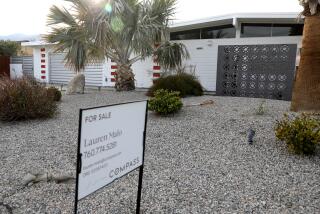Armchair Open House
- Share via
At last, a pastime for open-house junkies that doesn’t involve wear and tear on the car or excessive pavement pounding:
Introducing the virtual home tour, now available to the mouse-wielding, home-shopping public over the Internet.
Virtual home tours allow the potential home buyer--and legions of looky-loos--to see 360-degree views of a listed home, all while seated in front of a personal computer, clicking the mouse pointer to pan around the rooms, the yard, even the neighborhood.
As one real estate industry consultant put it, virtual tours “allow you to do an open house at home in your boxer shorts.”
But much more important than the potential for casual house hunting is the time savings for both consumer and realty agent, tour proponents say.
“Just think how many homes you could tour in one hour versus driving the streets,” said David Miller, who plans to sell his Aliso Viejo townhome with the help of a virtual tour.
Miller heard about the virtual tour possibility from local agent Debbie Burton, who in January began offering to create virtual tours for all homes she lists, at a cost to her of about $100 a home.
Burton, of Fred Sands Platinum Properties in Irvine, said the tours give buyers “much more of an idea of a home than just a picture of the exterior” can give them.
Finding a tour attached to a listing is still comparatively rare, but sites such as https://www.Homeseekers.com, https://www.Realtor.com, https://www.Listinglink.com, https://www.Homeshark.com, https://www.NewHomeNetwork.com and https://www.Homebuilder.com all report they’ll soon be incorporating many more virtual tours.
Advocates of the technology say home buyers will embrace it once it is more widespread, using it to pare down the list of homes they want to visit in person.
“Consumers are absolutely responding to this phenomenally,” said Kevin McCurdy, co-founder of Jutvision Corp., a Palo Alto company that created virtual tours for a variety of Canadian real estate clients before entering the U.S. market. “It saves people time, money and a lot of anxiety.”
The major companies that develop virtual tour hardware and software--Jutvision, Interactive Pictures Corp. of Oak Ridge, Tenn., and Cupertino, Calif.-based Be Here Corp.--hope their so-called immersive images will eventually replace all the flat photos that are now featured on Web-based listings.
Virtual tours, already popular for promoting hotels, cruise ships and sporting events, are just starting to catch on with real estate professionals, experts say.
It can take a little searching to find a home tour online, although sites such as https://www.Listinglink.com and https://www.Homeseekers.com promote them on their home pages, and the main home page for Coldwell Banker (https://www.coldwellbanker.com) includes tours for dozens of listings in several states.
Potential clients are impressed by a tech-savvy listing agent who can show off a sample tour on his or her laptop during an initial meeting, said Jim Phillips, chief executive of Interactive Pictures, whose process is known as Ipix.
“It increases their batting average incredibly,” Phillips said.
Although the technology used to create virtual tours varies, the starting point is when a specially trained photographer (or in some cases, a specially trained realty agent) comes to the house and records images of the exterior and some of the rooms. Then the different companies use proprietary software to manipulate the film or digitized pictures into “seamless” images.
When a home buyer views the finished product on the Web or a compact disc, it’s like standing in the middle of a room and turning in a circle to look around, up and down.
The viewer can even zoom in on a specific spot, although usually all that happens is that the chosen area appears magnified but more jagged-edged and indistinct.
And sure, all the panning and zooming can make you a bit seasick if you get the mouse moving too fast. Still, the tour is an efficient method, proponents say, for consumers to judge whether they’re at all interested in a home.
New home builders are also using virtual tours to showcase their products.
Pete Petermann of Watt Homes in Salt Lake City, a division of Irvine-based Laing Homes, said that if his company doesn’t have any models of a certain floor plan available for walk-throughs, buyers can tour a model home virtually instead.
Seeing a floor plan come to life complete with furnishings, “created an emotional tour of the home,” said Petermann, adding that buyers often have trouble envisioning the finished home from looking at plans. “It becomes more of a presentation that a novice can understand,” he said.
Watt Homes has tours available on https://www.Homebuilder.com for six of the 25 floor plans now under construction in the Salt Lake City area. Petermann said it’s likely that Laing Homes will eventually create tours for new projects in California as well.
The cost to create a virtual tour ranges from about $100 to more than $500, depending on the number of rooms in a house that are photographed and the technology selected to create the tour. In some cases, realty agents pay the tour-creating company extra fees to have their tours loaded onto more than one Web site.
The listing agent or home builder bears the cost, which has dropped sharply from a few years ago, when specialty cameras cost up to $25,000.
In the past, the process of creating a tour was cumbersome as well as expensive. A photographer had to take a series of about 10 perfectly aligned pictures, then have them electronically “stitched” together to form a panorama. Today, new techniques are more streamlined.
Manufacturers claim that using their combinations of technology and services, a virtual tour can be requested, shot and on the Web in less than three days, sometimes much faster.
And once a tour is available to the public, as homeowner David Miller noted, “That means my house is being shown by thousands of agents every day and I don’t even have to unlock the front door.”
But that very feature, considered a convenience for some, is viewed by others as an invasion of privacy.
“How would you feel knowing 70 million people were looking at your house?” asked Joan Young of Young Realtors in Westlake Village. A tour--especially of an expensive home with valuable knickknacks--could encourage burglars, Young said.
Gregg Larson, a real estate and technology analyst with Clareity Consulting in Minneapolis, agreed.
“Thieves can recognize good art when they see it,” Larson said.
Skeptics’ other concern is that getting a tour on the Internet is not the lightning-fast process the tour companies would have the public believe. Houses must be cleaned up, schedules coordinated among photographer, agent and seller, film must be processed.
In an especially hot market, Young said, there isn’t time to mount a virtual tour.
“Everybody thinks technology is instantaneous, and it’s not,” she said.
Real estate industry veterans agree that even if virtual tours become as commonplace as lawn signs, it will still be highly unusual for a buyer to make an offer without setting a real, live foot in the place.
Larson, the consultant who imagined the open-house-in-boxer-shorts scenario, says tours will never totally eclipse age-old home-selling practices.
“It may save a trip or two,” Larson said, “but it’s not going to stop people from riding around in the backs of cars.”
More to Read
Inside the business of entertainment
The Wide Shot brings you news, analysis and insights on everything from streaming wars to production — and what it all means for the future.
You may occasionally receive promotional content from the Los Angeles Times.










